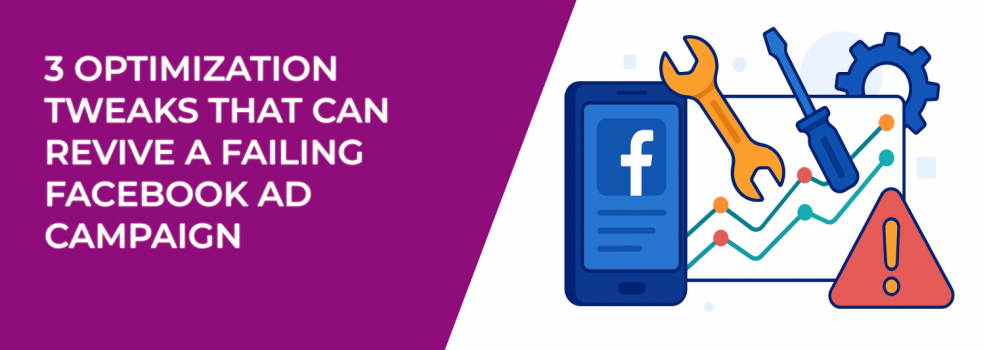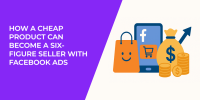When your Facebook ad campaign starts to fail, it’s easy to panic. You tweak the budget, change the headline, or swap out the creative — and still, nothing seems to work.
So, what do you do when nothing’s getting results?
Before you throw more money at the problem or shut everything down, take a moment to pause. Facebook ads don’t fail because your product is bad. Most of the time, it’s because the campaign isn’t aligned with the right audience, the creative, or the overall strategy.
Here are three simple but powerful changes you can make to turn your failing campaign around. These aren’t just generic tips — they’re proven tweaks that can turn wasted budget into real growth.
1. Fix Your Audience Targeting (Stop Trying to Reach Everyone)
When a Facebook campaign isn’t performing, the first thing to check is always your audience. Many advertisers make the mistake of targeting too broadly. They use a bunch of vague interests, hoping to cast a wide net and reach more people. Unfortunately, that’s not effective targeting — it’s more like throwing spaghetti at the wall and hoping it sticks.
Why it matters:
Facebook’s algorithm works best when it’s given specific, quality data to optimize with. If you target too broadly, your ad spend will be wasted on people who aren’t likely to convert, leading to higher costs and lower results.
Here’s how to fix it:
-
Refine your custom audiences.
Instead of targeting everyone who visited your website, break it down into more specific groups. For example, target people who have viewed specific product pages or added items to their cart but didn’t purchase. These people are much more likely to convert. -
Use Lookalike Audiences strategically.
A lookalike audience is a powerful tool, but you need to use it properly. Create lookalikes based on high-value actions, like customers who have made purchases or who engage with your brand frequently. Don’t just rely on a general email list — go deeper. For more tips on optimizing Facebook targeting, check out How to Optimize Facebook Ads with Lookalike Audiences. -
Exclude low-quality audiences.
If you’re targeting people who visited your site for a second but bounced off quickly, it’s time to exclude them. You should also exclude anyone who’s already made a purchase if you're focusing on new customers. Learn more about the importance of targeting the right audience in our guide to Custom vs Lookalike Audiences.
For example, if you sell fitness products, don’t just target “fitness” as an interest. Instead, create a custom audience of people who have visited specific product pages or added items to their cart but didn’t check out. Then, create a lookalike audience based on people who have actually purchased. By excluding people who already bought, you’ll save money on showing ads to people who don’t need them.
2. Refresh Your Creative (Make It Stand Out)
Even if you have the perfect audience, if your creative isn’t engaging, your campaign will fail. Creative is often the key difference between an ad that performs and one that gets ignored. If your ad isn’t grabbing attention, people will scroll right past it — no matter how great your product is.
Why it matters:
You’ve got just a few seconds to grab someone’s attention on Facebook. If your creative doesn’t stand out in those first 3 seconds, people won’t even give it a second glance. For more tips on creative performance, read about Crafting Compelling Facebook Ad Copy That Converts.
Here’s how to refresh your creative:
-
Start with a scroll-stopper.
The first few seconds of your ad are crucial. Use bold, unusual visuals or attention-grabbing headlines. Think about what will make someone stop scrolling — bright colors, movement, or something that stands out from the typical ads they see. -
Tailor the message to your audience’s stage.
If you’re targeting new, cold audiences, your ad should spark curiosity or address a pain point. For warmer audiences (people who have interacted with your brand), show proof, like customer testimonials, or offer a discount to encourage conversions. -
Test more authentic, “ugly” creative.
Some of the best-performing ads don’t look like polished, professional marketing materials. Try testing user-generated content (UGC) or simple, raw videos that show your product in action. These can feel more authentic and resonate better with your audience. -
Optimize for sound-off.
Most people watch videos on Facebook with the sound off, so make sure your ad still tells the story visually. Use subtitles or captions and make your visuals strong enough to communicate the message even without audio.
Let’s say you’re selling a fitness program. Instead of a highly produced ad with a voiceover, try a simple video of a customer talking about their experience and results. This authentic, real-life approach often performs better because it feels more relatable.
3. Rethink Your Campaign Objective and Optimization Event
Another common mistake is choosing the wrong campaign objective. If you set your campaign to optimize for clicks, that’s all you’ll get — clicks, not conversions. Facebook will only optimize for the event you tell it to, so if you’re focusing on the wrong metric, you won’t get the results you want. For an in-depth understanding of Facebook’s objectives, read Meta Ad Campaign Objectives Explained: How to Choose the Right One.
Why it matters:
Facebook’s AI is designed to help you reach your goals — but it can only do that if you set up your campaign with the right objective. For example, if you want to drive sales, you should optimize for purchases, not link clicks.
Here’s how to fix this:
-
Always optimize for conversions.
If you’re selling a product, use the “Conversions” objective with a “Purchase” event. This will help Facebook show your ad to people who are more likely to buy, not just click on your ad. -
Avoid traffic and engagement objectives for sales.
These objectives might get you clicks and likes, but they won’t help you make sales. Stick with “Conversions” when your goal is to drive actual purchases. -
Use Advantage+ Shopping campaigns if you have data.
Meta’s Advantage+ Shopping campaigns allow you to leverage automated optimizations that work better with larger datasets. These campaigns are perfect for advertisers with a healthy amount of historical data.
For example, let's say you’re selling high-end electronics. Instead of selecting the “Traffic” objective, go for Conversions with a Purchase event. Facebook will focus on people who are more likely to buy, not just people who will click.
Final Thoughts: Small Tweaks, Big Impact
If your Facebook campaign isn’t performing, don’t panic. More often than not, the issue is something small that can be fixed. Start by reviewing your audience: Are you targeting the right people? Take a closer look at your creative: Is it catching attention and aligned with where your audience is in the buying process? Finally, make sure you’re optimizing for the actions that matter — like purchases, not clicks.
By making these three key tweaks — to your audience, creative, and optimization settings — you can give your campaign the boost it needs to start driving real results. For further guidance, read How to Optimize Facebook Ads for E-commerce.

